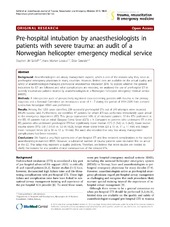| dc.contributor.author | Sollid, Stephen J. M. | en_US |
| dc.contributor.author | Lossius, Hans Morten | en_US |
| dc.contributor.author | Søreide, Eldar | en_US |
| dc.date.accessioned | 2011-04-19T08:59:39Z | |
| dc.date.available | 2011-04-19T08:59:39Z | |
| dc.date.issued | 2010-06-14 | eng |
| dc.Published | Scandinavian Journal of Trauma, Resuscitation and Emergency Medicine 18:30 | en_US |
| dc.identifier.issn | 1757-7241 | |
| dc.identifier.uri | https://hdl.handle.net/1956/4676 | |
| dc.description.abstract | Background Anaesthesiologists are airway management experts, which is one of the reasons why they serve as pre-hospital emergency physicians in many countries. However, limited data are available on the actual quality and safety of anaesthesiologist-managed pre-hospital endotracheal intubation (ETI). To explore whether the general indications for ETI are followed and what complications are recorded, we analysed the use of pre-hospital ETI in severely traumatised patients treated by anaesthesiologists in a Norwegian helicopter emergency medical service (HEMS). Methods A retrospective audit of prospectively registered data concerning patients with trauma as the primary diagnosis and a National Committee on Aeronautics score of 4 - 7 during the period of 1994-2005 from a mixed rural/urban Norwegian HEMS was performed. Results Among the 1255 cases identified, 238 successful pre-hospital ETIs out of 240 attempts were recorded (99.2% success rate). Furthermore, we identified 47 patients for whom ETI was performed immediately upon arrival to the emergency department (ED). This group represented 16% of all intubated patients. Of the ETIs performed in the ED, 43 patients had an initial Glasgow Coma Score (GCS) < 9. Compared to patients who underwent ETI in the ED, patients who underwent pre-hospital ETI had significantly lower median GCS (3 (3-6) vs. 6 (4-8)), lower revised trauma scores (RTS) (3.8 (1.8-5.9) vs. 5.0 (4.1-6.0)), longer mean scene times (23 ± 13 vs. 11 ± 11 min) and longer mean transport times (22 ± 16 vs. 13 ± 14 min). The audit also revealed that very few airway management complications had been recorded. Conclusions We found a very high success rate of pre-hospital ETI and few recorded complications in the studied anaesthesiologist-manned HEMS. However, a substantial number of trauma patients were intubated first on arrival in the ED. This delay may represent a quality problem. Therefore, we believe that more studies are needed to clarify the reasons for and possible clinical consequences of the delayed ETIs. | en_US |
| dc.language.iso | eng | eng |
| dc.publisher | BioMed Central | eng |
| dc.rights | Attribution CC BY | eng |
| dc.rights.uri | http://creativecommons.org/licenses/by/2.0 | eng |
| dc.title | Pre-hospital intubation by anaesthesiologists in patients with severe trauma: an audit of a Norwegian helicopter emergency medical service | en_US |
| dc.type | Peer reviewed | |
| dc.type | Journal article | |
| dc.description.version | publishedVersion | en_US |
| dc.rights.holder | Copyright 2010 Sollid et al; licensee BioMed Central Ltd. | |
| dc.rights.holder | Sollid et al | |
| dc.identifier.doi | https://doi.org/10.1186/1757-7241-18-30 | |
| dc.identifier.cristin | 518997 | |
| dc.subject.nsi | VDP::Medical disciplines: 700 | eng |

